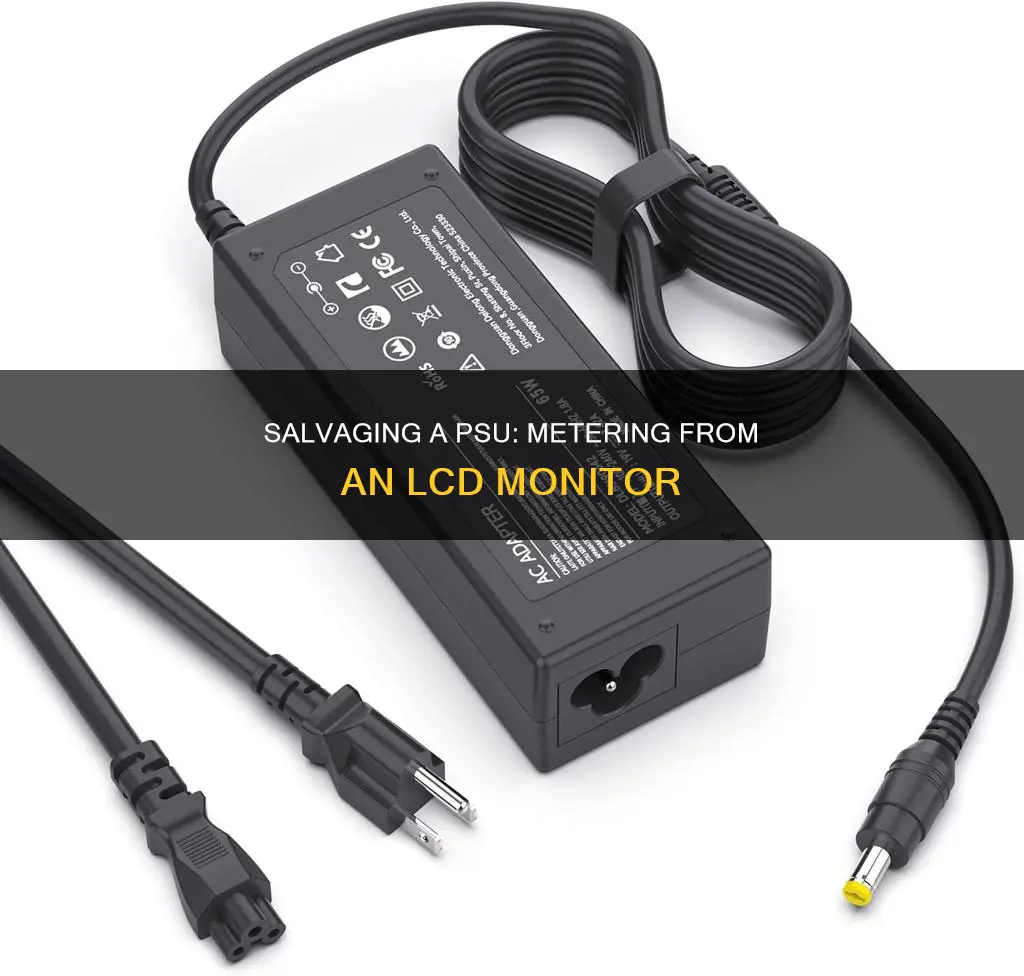
If you're looking to test a PSU from an LCD monitor, there are a few ways to go about it. Firstly, you can use a multimeter to test the PSU, which is a safe method if you follow basic guidelines. You should not open up the PSU itself, as this can give you a lethal shock. Instead, you can test the output of the PSU by following online guides and tutorials. You can also use a PSU tester, which is a quicker method, and can give you useful values like the Power Good (PG) value. Another option is to use an Arduino and LCD monitor to create a bench PSU power supply, which provides 12v, 5v, and 3.3v outputs, has an LCD monitor to show voltages, and allows for easy access to a power source.
| Characteristics | Values |
|---|---|
| Required tools | Digital multimeter, ATX PSU jumper bridge tool, paper clip, soldering iron and solder, wire strippers, wire cutters, Arduino Nano, Arduino Nano terminal board, 20x4 HD44780 LCD, I2C module for LCD, DC step-up/down module, MDF wood, small screws, hot glue gun, Dremel, sandpaper, black spray paint, MDF primer, voltmeter |
| Required knowledge | Basic understanding of electronics and soldering, basic experience with Arduino |
| Risks | Lethal shock if proper precautions are not taken |
What You'll Learn

Testing a PSU with a multimeter
Step 1: Prepare the PSU
- Ensure the PSU is turned off. If it has a switch, turn it off. If it powers on automatically when connected to an outlet, unplug it.
- Disconnect all power cables from the PSU, except for the main AC cable and the 24-pin cable.
Step 2: Familiarize Yourself with the ATX Pinouts
Familiarize yourself with the layout and expected voltages of the 20/24-pin connector. The numbering scheme starts on the bottom left, with 1-12 on the bottom row and 13-24 on the top row for a 24-pin connector. For a 20-pin connector, it's 1-10 and 11-20.
Step 3: Jumper the Power On Pin
- Locate the power supply on pin (pin 16 on the 24-pin connector) and the ground pins on either side (pins 15 and 17).
- Use a paper clip or a PSU jumper to connect pins 16 and 15 or pins 16 and 17. Be careful not to touch the uninsulated part during the test.
- Turn the PSU back on. You should see and hear the fan spin. Some PSUs have a zero-RPM feature, so the fan may only spin briefly during power-up and then idle.
Step 4: Set Up the Multimeter
Turn on your multimeter and set it to DCV (DC voltage) mode. If your multimeter is auto-ranging, you don't need to do anything else. If not, set the range to 10V.
Step 5: Test the Pins
- Place the black probe of the multimeter on any of the grounded pins. For a 24-pin ATX connector, these are pins 3, 5, 7, 15, 17, 18, 19, or 24. We recommend using pin 15 as it is adjacent to the power jumper.
- With the black probe on the grounded pin, touch the red probe to the other pins individually to get voltage readings.
- Compare the readings to the expected voltages. For example, if you ground on pin 15 and touch pin 12, the readout should be 3.3V or within ±5% of that value.
- Repeat this process for all the pins, confirming that the voltage readings are within the acceptable range.
- If any values are outside the expected range, it's time to replace the PSU.
LCD LED-lit Monitor: How Long Should It Last?
You may want to see also

Using a PSU tester
Firstly, ensure the power is off on the PSU. If your PSU has a switch, turn it off. If it powers on automatically when connected to an outlet, unplug it.
Next, disconnect all the power leads from your PSU. This is a safety precaution, as it is unlikely but possible that something could go wrong during the test and damage adjacent components.
Now, locate the power supply on pin and the adjacent ground pins. You will need to bridge the power supply pin with one of the ground pins. This can be done with a paper clip, a scrap piece of 18AWG or 16AWG wire, or a simple ATX 24-pin PSU jumper bridge tool.
Once the power supply pin and ground pin are bridged, turn the PSU back on. You should hear and see the fan spin up. Some PSUs feature a fan that only briefly spins up during the power-up process and then idles until the PSU temperature rises, so don't be alarmed if the fan spins and then stops.
With your PSU tester, plug in the 24-pin cable along with the 8-pin (4+4) CPU cable into the tester and to the PSU. Then, plug in the AC power cord and flip the power switch to the On position. The LCD screen on the PSU tester should power on and show numeric readouts. PG (Power Good) values are usually considered normal if they fall within the range of 100ms-500ms, but can sometimes be lower than 100ms. A 0ms PG value indicates a failing PSU.
To test peripheral/SATA power connections, unplug the PSU from the AC power cable and switch it off. Then, plug in either a single peripheral or SATA connection and switch the PSU back on after plugging in the AC power cable. The lights on the left side of the tester should light up to indicate power delivery. For a SATA connection, all three lights should light up (+12V, +3.3V, & +5V). For all other peripheral cables, only +12V and +5V will power on.
Finally, unplug the AC power cable when testing is complete before unplugging the PSU cables. If any of the voltage ranges are outside of the parameters, your PSU may be malfunctioning.
Ultimate Monitor Size for the Nintendo Unisystem Arcade
You may want to see also

Testing a PSU with a paper clip
Step 1: Power off your PC and ensure that the main power switch on the back of the PSU is turned off.
Step 2: Disconnect the 24-pin connector from your motherboard. This connector is typically found on the right-hand side of the motherboard, closer to the top.
Step 3: Locate pin 4 and pin 5 on your 24-pin cable. To find these pins, count from the left with the clip facing up and the pins facing towards you.
Step 4: Take a standard-size paper clip and unfold it into a long piece. You can also use a piece of wire of similar thickness.
Step 5: Bend the paper clip so that the ends can be inserted into pin 4 and pin 5.
Step 6: Turn on the PSU by flipping the switch on the back to the 'on' position.
Step 7: Observe if the PSU fan turns on. If it does, the PSU is functioning normally. Additionally, if your PSU is connected to case fans and LEDs, they should also turn on, indicating functionality.
It is important to note that this testing method is not foolproof, and there is a possibility that another component could have failed even if the PSU appears to be working. If none of the connected components turn on, then it is likely that the PSU is faulty.
Always exercise caution when working with power supplies. Do not open the PSU itself as it can expose you to dangerous line-level electricity and capacitors. If your PSU is malfunctioning, the safest course of action is to simply replace it.
Enabling G-Sync on Your ASUS Monitor: A Step-by-Step Guide
You may want to see also

LCD monitors with PSU problems
One common issue with LCD monitors is capacitor failure, which can cause the capacitors to leak and bulge, resulting in the monitor not turning on. To fix this, you will need to replace the faulty capacitor with a new one. It is important to make sure that the new capacitor has the same or higher voltage rating as the old one, and that the polarity is correct when soldering it into the circuit board.
Before attempting any repairs, it is recommended to check for any visible signs of damage, such as a domed or leaking capacitor. Additionally, most monitors have a self-test function, and the power light will blink in a specific pattern to indicate an error. If the monitor does not have a clear picture, the error is most likely a bad backlight.
To properly troubleshoot an LCD monitor, it is helpful to have the service manual and datasheet for the display panel, as well as some basic test equipment such as a multimeter, backlight tester, and transistor tester for the MOSFET on the PSU.
If your graphics card is not receiving enough electricity, it could be damaged or disconnect, resulting in display issues. In this case, the problem is likely with the PSU and not the monitor itself.
It is also worth noting that attempting to replace large capacitors, transformers, or other internal PSU components is an advanced electronics repair that may not be worth the effort, given the relatively low cost of replacement PSUs.
Bigger Monitors: Better Quality or Just Enlarged Pictures?
You may want to see also

Building a Bench PSU with an LCD monitor
Building a bench power supply (PSU) from an LCD monitor can be a great way to create a reliable and adjustable power source for your electronics projects. This project involves converting an old computer PSU into a bench PSU with an LCD display for monitoring voltages. Here's a step-by-step guide to help you through the process:
Choosing the Right PSU:
- Consider the power requirements of your projects and choose a PSU with an adequate power rating. Look for PSUs with 300 watts or higher.
- Modular PSUs with detachable cables are preferable for better cable management.
- Ensure the PSU provides the required output voltages (+12V, +5V, +3.3V) and currents for your needs.
- Look for efficient and reliable PSUs with certifications like 80 Plus Bronze, Silver, Gold, or Platinum.
- Choose a PSU with quiet operation and good cooling features to minimize fan noise.
Gather Tools and Materials:
- Screwdriver set (Phillips and flathead)
- Multimeter
- Heat shrink tubing and heat gun
- Soldering iron and solder
- Drill
- Electrical wires (various colors and gauges)
- Terminal blocks or binding posts
- Voltage regulator module (if not in the PSU)
- Digital voltmeter or voltage display module
- Enclosure or box for housing the PSU
- Power switch and indicator LED (optional)
- Screws, nuts, standoffs, etc.
Safety Precautions and Disassembly:
- Disconnect the PSU from any power source and detach batteries or UPS connections.
- Discharge capacitors by pressing and holding the power button.
- Work in a well-ventilated area or use a fume extractor.
- Wear personal protective equipment (PPE), including safety goggles, gloves, and an anti-static wristband.
- Open the PSU casing carefully and expose the internal components.
Identifying and Removing Unnecessary Wires:
- Identify the main power connectors (24-pin, 20+4-pin for motherboard, 4/8-pin for CPU).
- Locate Molex connectors (4-pin), SATA connectors (for HDDs/SSDs), PCIe connectors (for graphics cards), and any extra connectors.
- Determine unused connectors and trace the wires to their destination.
- Cut or desolder unnecessary wires and secure loose ends with heat shrink tubing or electrical tape.
Wiring the PSU for Bench Power Supply Use:
- Identify the output wires for +12V, +5V, and +3.3V.
- Strip and tin the ends of these wires.
- Connect the wires to terminal blocks or binding posts, ensuring tight and secure connections.
- Use color-coded wires for different voltage outputs to keep wiring organized.
- Establish a proper ground connection by connecting black wires to a common ground terminal.
- Insulate and secure all connections with heat shrink tubing or electrical tape.
Building the Bench Power Supply Box:
- Choose an enclosure that accommodates the PSU and other components with proper ventilation.
- Measure and mark the dimensions, leaving space for cable management.
- Drill mounting holes and cut openings for connectors as needed.
- Consider adding a cooling fan if necessary.
- Label the different power outputs clearly.
Installing Power Output Terminals:
- Choose suitable terminals like banana jacks, binding posts, or terminal blocks.
- Mark the positions for the terminals on the enclosure.
- Drill mounting holes and insert the mounting hardware.
- Connect the power output wires (+12V, +5V, +3.3V) to the appropriate terminals and insulate the connections.
- Label each power output terminal with the corresponding voltage level.
Installing Voltage Regulator and Display:
- Choose a suitable voltage regulator module (e.g., LM317 or LM338).
- Identify the input, output, and adjustment pins of the voltage regulator.
- Mount the voltage regulator inside the enclosure with easy access to terminals.
- Connect a wire from the PSU's +12V output to the input terminal of the voltage regulator.
- Connect a wire from the output terminal of the voltage regulator to a power output terminal.
- Wire the adjustment pin to a potentiometer or fixed resistor to fine-tune the output voltage.
- Mount a digital voltmeter or voltage display module and connect it to the voltage output terminals.
- Test the regulator and display to ensure correct functionality.
Finalizing the Bench Power Supply:
- Secure and organize the wiring inside the enclosure using zip ties or cable management solutions.
- Check for sufficient clearance between components and ensure proper airflow.
- Install a power switch and indicator LED for convenient power control.
- Seal and insulate any openings to prevent electrical shock or dust accumulation.
- Test the bench PSU thoroughly using a multimeter to verify voltage outputs and regulator accuracy.
By following these steps, you can create a functional and safe bench PSU with an LCD monitor, providing a versatile power source for your electronics projects. Remember to prioritize safety and refer to detailed guides or tutorials for specific instructions and troubleshooting.
Monitoring Electricity Usage: A Guide for Irish Homes
You may want to see also
Frequently asked questions
PSU stands for Power Supply Unit.
You can test a PSU with a multimeter or a power supply tester. If you want to test it with a multimeter, follow these steps:
- Set your multimeter to the appropriate DC metering mode according to the manufacturer.
- Place the black test lead in contact with the 24th pin or any of the other Ground pins.
- Place the red test lead into the pins individually (1-2, 4, 6, 9-14, 21-23) to get a reading of the voltages from your PSU.
This is dependent on the monitor. Not all monitors have a simple power converter for one voltage output that can be easily bypassed. Older-style CCFL backlight monitors have a boost converter/ballast to take the low voltage DC up to a high voltage to make the lighting work.
A Molex cord is a type of power cord that can be used to power a monitor.
You will need a multimeter or a power supply tester. You will also need a paper clip or a PSU jumper to perform the test.







